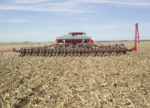Advertise Follow Us
Items Tagged with 'Poncho 500'
ARTICLES
No-tillers, equipment experts share their annual drill and planter maintenance checklists that are must-dos for successful stands.
Read More
Keeton Seed Firmer Makes It Two In A Row
From equipment to crop protection to precision tools, No-Till Farmer readers rated the best-performing no-till products for 2010.
Read More
Seed Treatments Taking Big Steps Forward
Once simple fungicides and insecticides, seed treatments are major multitaskers, tackling everything from insects to weather
Read More
Keeton Seed Firmer Gets Nod As Top Product Of 2009
No-Till Farmer readers speak up on the best no-till products for their no-till operations in 11 categories
Read More







